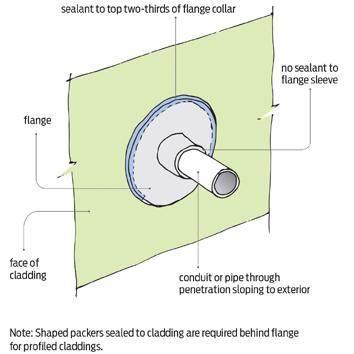
2 minute read
Going through the wall
Although it happens less frequently today, BRANZ still sees cases where penetrations cut through walls are not well done. Here’s their advice for getting it right.
Any time you cut a hole in a wall, it is crucial to get the details right so weathertightness is not compromised.
As always, the best option is to avoid a penetration completely if you can. When retrofitting a heat pump into an old house, for example, consider a floor console where pipes from the outdoor unit may be able to enter below floor level, avoiding a hole in the wall.
In Acceptable Solution E2/AS1, Figures 68 and 69 show how to make pipes and service penetrations through walls weathertight. For pipe penetrations, use flexible flashing tape to seal the pipe to the wall underlay or flange plate (as shown). There are also a range of proprietary penetration seals on the market (including BRANZ Appraised seals) that simplify this task.
When working on existing homes, the ideal is to follow E2/AS1, but because this will require removal of cladding, it is often not practical. (If the lining is being removed or replaced as part of a renovation, however, taping the penetration to the back of the underlay is an option.)
Steps to take when making a seal against the wall underlay isn’t an option:
Locate the penetration in as sheltered a position as possible—under/through the eaves/soffit (clothes dryer or exhaust vents) or on the sheltered side of a building Slope pipe penetrations down to the outside at least 1.5° Provide a hood or cowl to the penetration and seal this to the cladding. Install a flange around the pipe/sleeve (Figure 1). Apply sealant over a PEF backing rod around the opening, cover with the flange and seal just the top two-thirds of the flange collar against the cladding (Figure 2). Don’t seal the flange sleeve to the pipe because the sleeve lets water that gets past the flange drain out.
This article is reproduced from the ‘BRANZ Guideline’ (September 2020 edition). Find it at www.branz.co.nz/pubs/guideline/
Figure 1: Fitting a flange to a penetration on an existing wall
Conduit or pipe through penetration
Sealant over PEF backing rod Sealant to top two-thirds of flange collar
Flange
10mm
Minimum 1.5° slope to exterior
No sealant to flange sleeve Existing cladding
Cavity batten
Figure 2: The correct location for sealant on a flange
Sealant to top two-thirds of flange collar
Flange No sealant to flange sleeve

Face of cladding Conduit or pipe through penetration sloping to exterior










